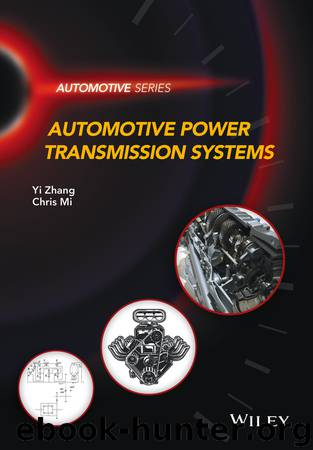Automotive Power Transmission Systems by Yi Zhang Chris Mi & Chris Mi

Author:Yi Zhang,Chris Mi & Chris Mi
Language: eng
Format: epub
ISBN: 9781118964903
Publisher: John Wiley & Sons, Inc.
Published: 2018-09-17T00:00:00+00:00
Pressure control solenoids (PCS), also called variable force solenoids (VFS) or variable bleed solenoids (VBS), work on the principle of pulse width modulation (PWM). In general, the operation of the pressure control solenoid can be explained by duty cycle and frequency. A duty cycle is the percent of time that electric current flows through the coil of the solenoid in a cycle whose time duration is defined by the frequency. In other words, a duty cycle is the percent of time in a cycle the TCU sends electric current through the coil. A pressure control solenoid works at a given specified frequency. For example, GM transmission Hydra‐Matic 4 T80‐E uses a frequency of 614 Hz for the pressure control solenoid [16]. A 20% duty cycle means that electric current flows in the solenoid coil for 0.2 × (1/614) s (approximately 0.0003 s) in every cycle that lasts for 1/614 s (approximately 0.0016 s), as shown in Figure 6.2. The current in the solenoid coil generates a magnetic field that fills the center of the electronic portion in which the armature is located. The magnetic force, the force of the push rod spring, the hydraulic pressure force on the end of the valve core, and the spring force on the valve core interact with each other to vary the armature and valve core positions for the accurate control of the torque signal pressure.
The pressure control solenoid shown in Figure 6.2 is actually a variable bleed valve (VBS) and can be either “normally high” or “normally low”. A normally high pressure control solenoid regulates torque signal pressure in reverse proportion to the current in the coil. The line pressure control solenoid in Figure 6.1 is normally low. It controls the line pressure by bleeding more or less ATF from the valve as controlled by the TCU according to the engine load and vehicle operation conditions. The line pressure needed to secure transmission control functionality varies with the engine load which is reflected by the engine throttle opening. As engine throttle increases, the line pressure is also increased by bleeding less ATF from the pressure control valve through the decrease of duty cycles. By contrary, a normally high pressure control solenoid regulates the out‐port pressure in direct proportion to the current in the coil; that is, to increase the out‐port pressure, the TCU increases the duty cycles of the coil. Note that the PCS or VFS is energized by duty cycles through PWM by TCU, but the ATF pressure controlled is calibrated against the current through the solenoid coil. When applied in the transmission control system, the TCU monitors the current in the electric circuit from the solenoid to ground and uses this as the feedback to adjust the duty cycles for accurate control of torque signal pressure.
Shift solenoid: This is actually an electronically controlled switch valve in the transmission hydraulic circuit and only has two states: On or Off. A combination of On and Off states of shift solenoids defines a particular gear position. For example, two shift solenoids
Download
This site does not store any files on its server. We only index and link to content provided by other sites. Please contact the content providers to delete copyright contents if any and email us, we'll remove relevant links or contents immediately.
Whiskies Galore by Ian Buxton(41557)
Introduction to Aircraft Design (Cambridge Aerospace Series) by John P. Fielding(32902)
Small Unmanned Fixed-wing Aircraft Design by Andrew J. Keane Andras Sobester James P. Scanlan & András Sóbester & James P. Scanlan(32587)
Aircraft Design of WWII: A Sketchbook by Lockheed Aircraft Corporation(32141)
Craft Beer for the Homebrewer by Michael Agnew(17949)
Turbulence by E. J. Noyes(7727)
The Complete Stick Figure Physics Tutorials by Allen Sarah(7159)
The Institute by Stephen King(6812)
Kaplan MCAT General Chemistry Review by Kaplan(6626)
The Thirst by Nesbo Jo(6467)
Bad Blood by John Carreyrou(6290)
Modelling of Convective Heat and Mass Transfer in Rotating Flows by Igor V. Shevchuk(6240)
Learning SQL by Alan Beaulieu(6054)
Weapons of Math Destruction by Cathy O'Neil(5867)
Man-made Catastrophes and Risk Information Concealment by Dmitry Chernov & Didier Sornette(5682)
Permanent Record by Edward Snowden(5554)
Digital Minimalism by Cal Newport;(5412)
Life 3.0: Being Human in the Age of Artificial Intelligence by Tegmark Max(5209)
iGen by Jean M. Twenge(5184)
